For this week’s GP’s Classic Steel we are going to take a look back at the machine that featured Honda’s last great 250 two-stroke motor, the 2001 CR250R.
For this week’s GP’s Classic Steel we are going to take a look back at the machine that featured Honda’s last great 250 two-stroke motor, the 2001 CR250R.
 |
|
The 2001 CR250R marked the last year for both Honda second generation alloy chassis and perhaps the most successful two-stroke motor design of all time. |
The Honda CR250R remains one of the most storied machines in all of motocross. For more than three decades, the red rooster remained one of the most influential machines in the 250 class. The first truly competitive Japanese 250 in ‘73, the first to move to liquid cooling in ‘81, the first to offer cartridge forks in ’86, the first to offer Supercross-bred “low-boy” body work in ’88 and the first to jump to an aluminum frame in ’97. Along the way, they certainly had their share of misses, but also several epically great machines. Even today, the mid-eighties and early nineties CR250R’s are revered as some of the greatest motocross bikes ever produced. They were wicked fast, sharp handling and bred to win races.
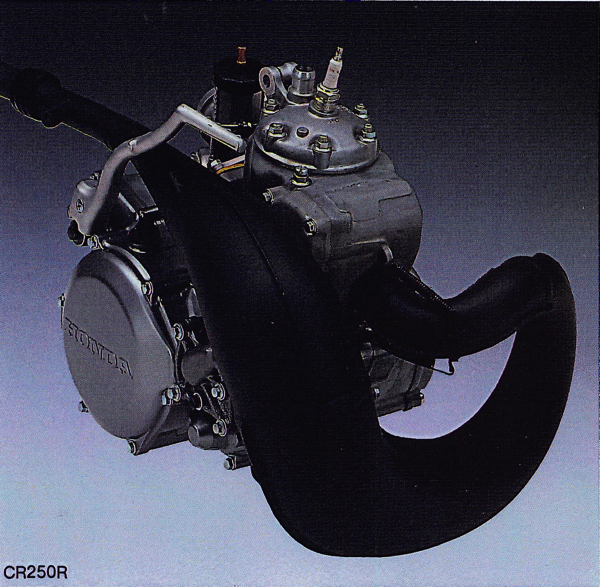 |
|
All hail the King: Originally introduced on the all-new 1992 CR250R, this 249cc power house was the epitome of two-stroke performance in the early and mid-nineties. After a few bumpy years at the end of the decade, the motor that took Red Riders to seven AMA 250 National and Supercross titles was finally back to form for 2001. |
Toward the end of the 1990’s, that Honda mystique began to tarnish, as a combination of technical gambles and greatly-improved competition began to chip away at Honda’s dominant position. A stitch to an aluminum chassis in 1997 wowed consumers initially, before the ZANG-POW factor gave way to sore wrists and a nasty front-end push. The new alloy chassis ruined Honda’s legendary handling, compounded their mediocre suspension and led many (including Jeremy McGrath) to lament the demise of their tried-and-true steel underpinnings.
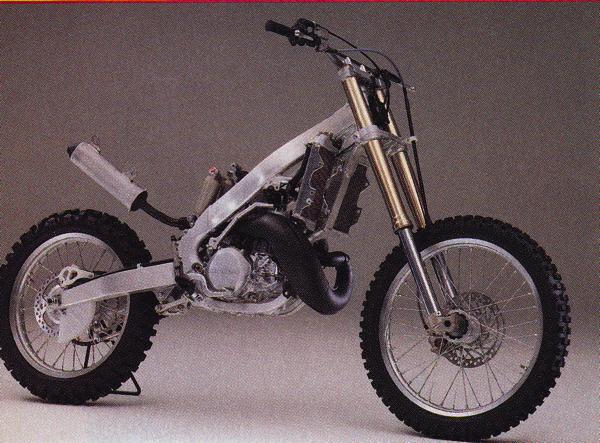 |
|
Jenny Craig: In 2000, Honda made the first major revision to their avant-garde alloy chassis design. The new frame was narrower, lighter, and more forgiving than the controversial ’97-’99 design. For 2001, Honda chose to largely stand pat with the CR’s chassis, and instead focused on getting their legendary power plant back up to snuff. |
In addition to their chassis woes, a series of motor missteps allowed the competition to catch and pass their once dominant power position. Starting in the mid-eighties, Honda had enjoyed a class-leading position in the 250 motor rankings. Nothing was as fast, flexible and fire breathing as Honda’s 250cc powerhouse. Then in 1997, a switch to a more top-end focused powerband opened the door for Kawasaki to snatch away the title of best deuce-and-a-half motor in the land. Brawny, burly and abrupt were the KX’s calling cards in the late nineties. These Kawasaki powerhouses got up and went at the twist of a wrist and left the other 250’s in their wake.
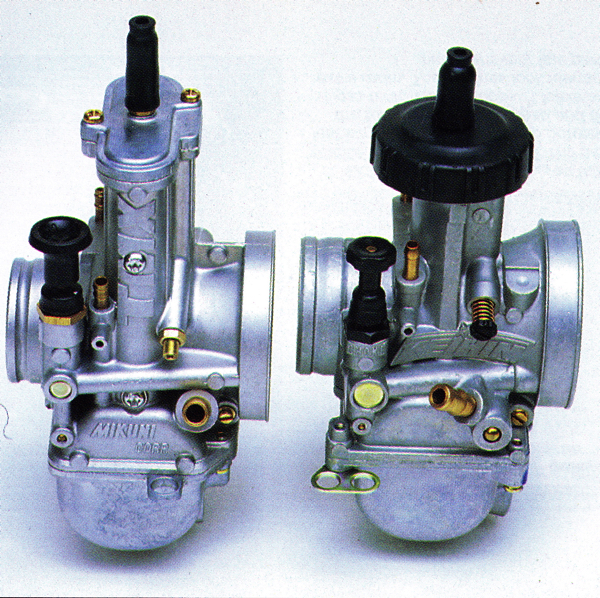 |
|
In 2001, Honda made the rather surprising move to scrap their long-time partner Keihin and go with a Mikuni TMX mixer. The swap in carbs yielded impressive power gains, but proved a tedious marriage, as the new vergaser proved infuriating to tune properly. |
While Kawasaki was busy convincing the masses to go green, Honda continued to try and sort out their Buck Rogers racer. Poor suspension remained a Honda bugaboo and the CR offered the least forgiving ride on the track. The overbuilt chassis offered very little feedback (aside from mind-numbing vibration) and the new motor continued to lack the ease-of-use of its earlier siblings. A switch to an unpopular mid-range only power curve for ’99 only exasperated matters and left long time Honda owners wondering if Big Red had lost their way.
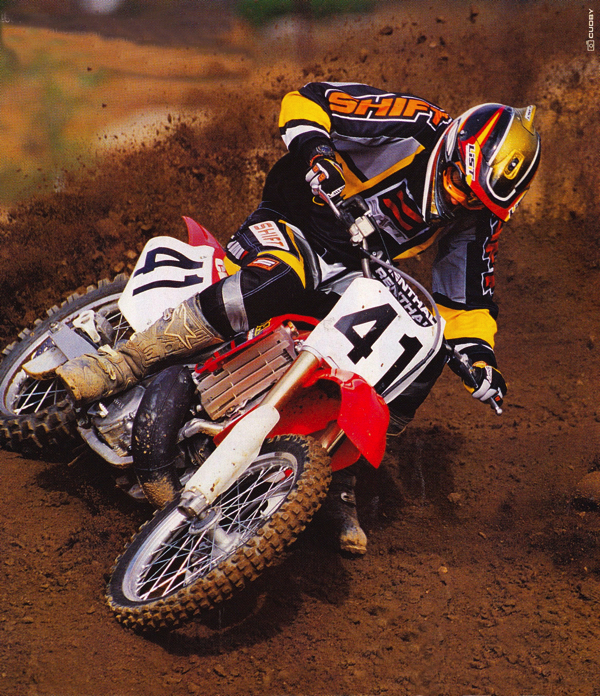 |
|
The changes made to the CR250R’s chassis in 2000 yielded major gains in performance. The second generation alloy chassis did away with most of the front-end push that annoyed riders on the ’97-‘99 bike and dialed some feel back into the ultra-rigid machine. While the CR was still a bit too-stiff for some rider’s tastes, it was rated by most to be the second best handling package of 2001. Photo credit: Simon Cudby |
For 2000, Honda took what they had learned from their rocky first foray into alloy frame building and channeled it into a much-improved design. All new from the ground up, the 2000 CR was lighter, leaner and better than the ’99 model in nearly every measurable way. The new chassis retained the aluminum construction of the ’97-’99 machines, but paired down the spar thickness, narrowed the midsection and dropped the dual down tubes in an effort to dial some flex back in to the ultra-ridged frame. New bodywork and a less butt-bruising seat improved ergos and helped bring some comfort back into the equation. Excess vibration continued to be an issue and the bike was still too stiff for some rider’s liking, but the overall handling was much improved.
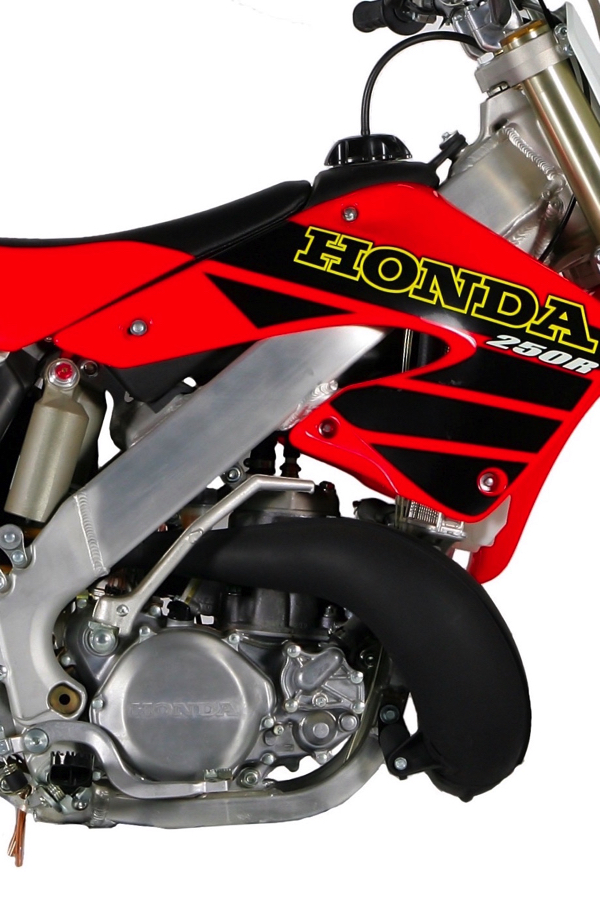 |
|
For 2001, several minor motor changes added up to major powerband improvements on Honda’s 249cc mill. A new expansion chamber, revised porting and a recalibrated ignition brought back the top-end power that had been sorely missing in 2000. |
For 2001, Honda chose to mostly stand pat in the chassis department and focus on bringing their award winning motor back up to snuff. New porting, a revised ignition curve and a redesigned exhaust looked to widen its midrange-focused powerband. In a big change for 2001, Honda ditched its decades old relationship with Keihin in favor of a new 38mm TMX carb from Mikuni. This switch would leave Honda with the only mixer of 2001 without a Power Jet or throttle position sensor. Finishing off the motor package was an all-new reed cage and slightly larger (20%) air intakes in the side panels to improve flow.
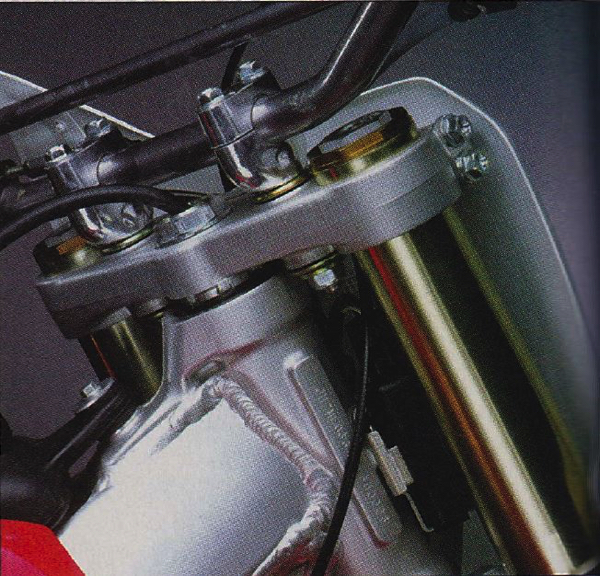 |
|
Ever since the introduction of the alloy chassis in 1997, vibration had been a major annoyance on Honda’s racers. The inclusion of rubber mounted bars helped dial down some of the unwanted harmonics in 2001. |
On the chassis side of things, the only big change for 2001 was the availability of a 20-inch wheel option for the first time. This was a popular mod on Factory team at the time and it was intended to improve front-end feel and take a little bite out of the overly stiff alloy chassis. In addition to the wheel option, BNG moved the “CR” from the shroud to the seat and a half-waffle grip made its appearance for the first time. Other than these few mods, the 2001 CR250R chassis remained basically unchanged from the year before.
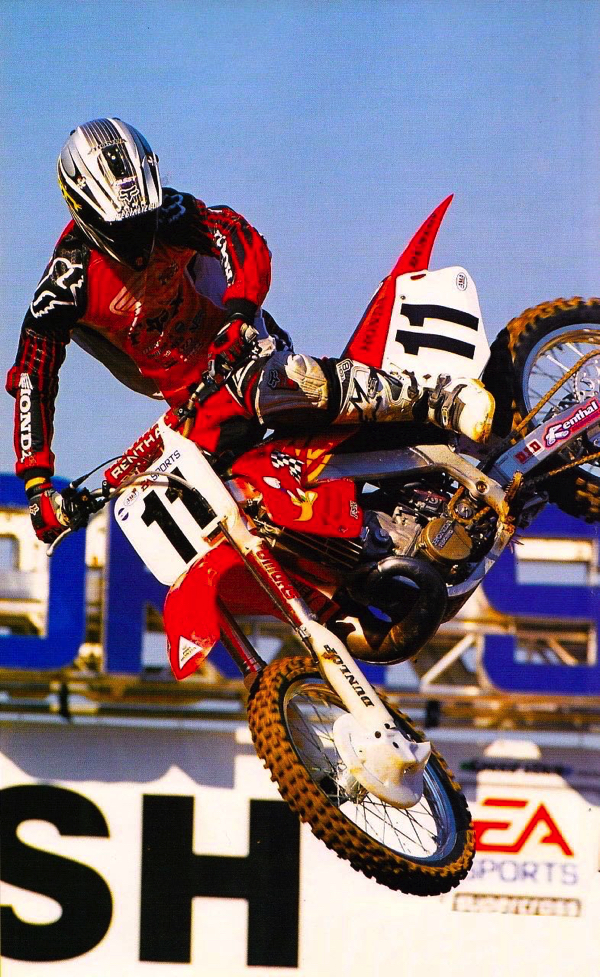 |
|
With the departure of Kevin Windham to Team Suzuki, it was left to Ezra Lusk and Sebastian Tortelli to represent the red team in 2001. After missing the entire 2000 Supercross season with an injury, Lusk would bounce back with a solid 2001. While a win would elude the Bainbridge, GA star, he would card seven podiums on his way to fifth overall in the Supercross series. Photo credit: Simon Cudby |
While the new bike looked largely unchanged, its performance was a major improvement. For the first time since the glory days of the early nineties, the CR was once again the conversation for best deuce-and-a-half motor of the year. Gone were the top-end focused mills of ’97-’98 and the mid-only power plants of ’99-’00. In their place was a broad and burly style of power that was a throwback to the glory days of Stanton and McGrath. Low-end power was decent but not in the same league as the torquey Kawasaki. Where the motor really came alive was in the midrange, where it hit hard and pulled with ferocity into a tire sheading top-end hook. The power was flexible and the bike required far fewer shift per lap than in 2000. With its mediocre low-end and explosive midrange, the CR could be a handful on slippery tracks, but if there was traction, it could run with anyone.
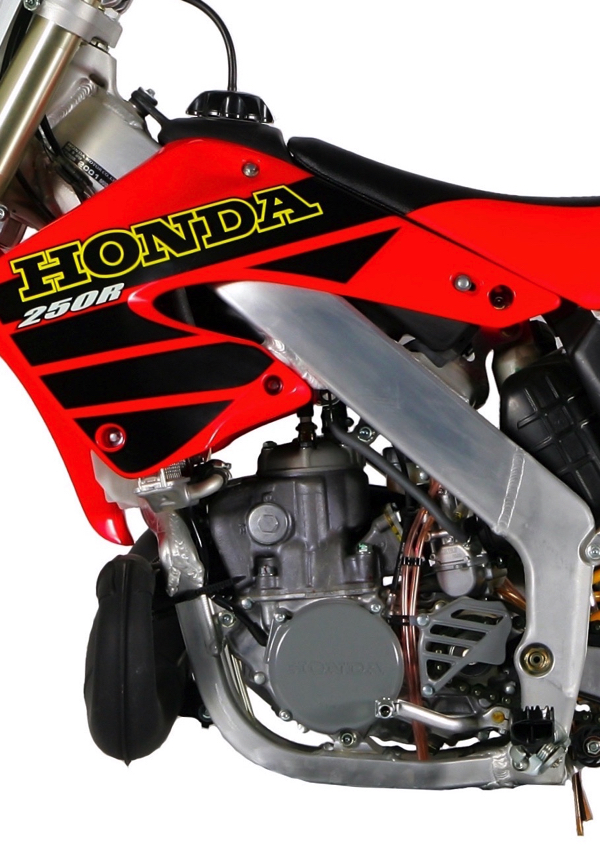 |
|
Sing the high note: After the narrow powerbands of ’99 and ’00 CR, the broad power of the ’01 model was a welcome return to form. Not as torquey as the Kawasaki or Yamaha, the Honda did its best work from the midrange on up. |
While the overall power was much improved, there were still some problems. By far the biggest of these was the new TMX carb, which proved nearly impossible to jet correctly. It was rich down low (helping to exasperate the lackluster low-end response) and lean on top. Sorting this out proved a tight wire act, as leaning out the low-end seemed to mute the midrange hit and fatting up the main led to a burble in the mid-to top transition. By keeping a stable of jets and needles at the ready, you could make it work, but it was never quite right and proved far more finicky to live with than the other 2001 offerings.
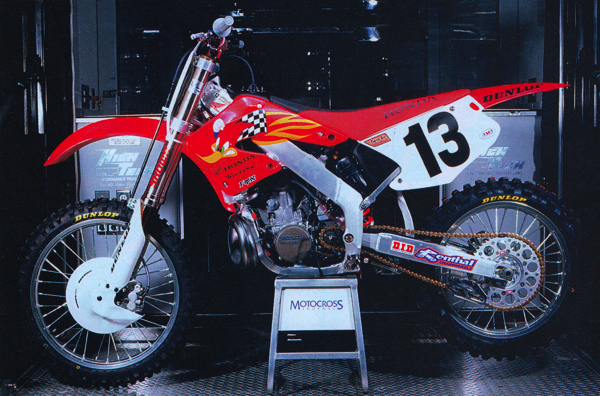 |
|
Woody: Team Honda picked up a major outside sponsor in 2001 by partnering with Universal Studios. While somewhat controversial at the time, the Woody Woopecker logo would become an iconic part of Honda’s early 2000’s success. Photo credit: Motocross Journal |
As to the handling, the CR250R remained more or less the same bike it had been in 2000. The second-generation alloy chassis was less overbuilt than the ’97-’99 offering, and did away with much of the numb feel and front-end push that plagued the gen one design. The slightly more compact dimensions and revised geometry were a huge improvement and brought back most of ’94 -’96 CR’s turning prowess. The Honda offered better turning than the yellow, green and orange offerings, but slightly less precision than the excellent YZ. On fast straights, there was still a little headshake, but it was less twitchy than pre-2000 CR’s. While the 20-inch front wheel was big news, testers were split on its actual benefits. In certain conditions (notably hard-pack), it seemed to offer sizeable improvements, while in others, its virtues were more ambiguous. Overall, it gave the front end a slightly plusher feel that was most noticeable on hard and choppy tracks.
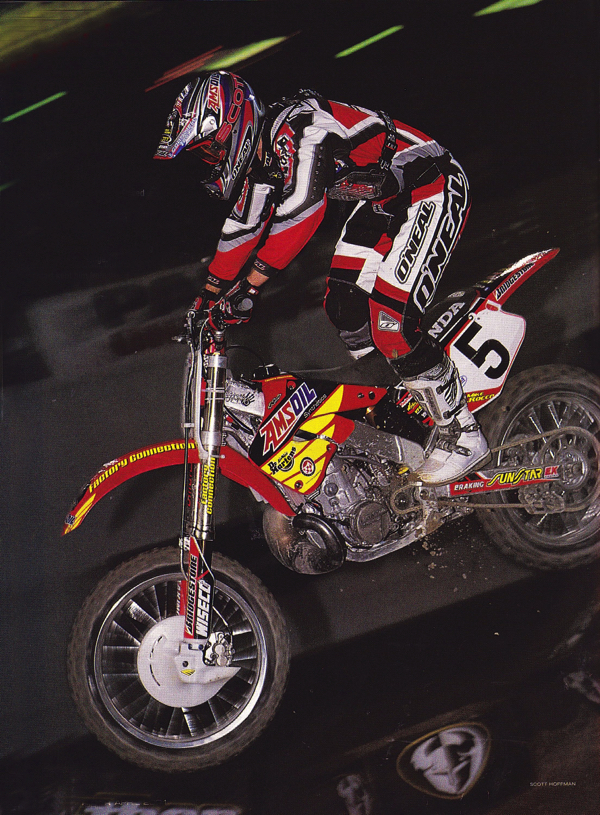 |
|
While not officially a part of the Factory Team, Mike LaRocco would join Lusk and Tortelli on works Hondas in 2001. In Supercross, The Rock would take his Amsoil Factory Connection backed CR250R to fourth overall. Outdoors, Mike would end up switching to the prototype Factory Honda CRF450R and card a third overall in the final standings. Photo credit: Scott Hoffman |
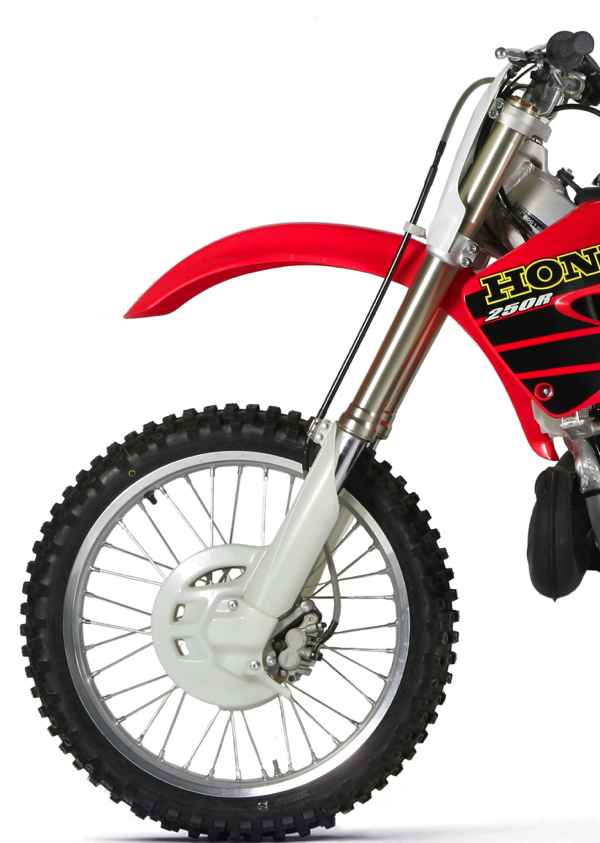 |
|
Perhaps the weakest link in the 2001 CR’s arsenal were these Showa Twin-Chamber inverted forks. While smoother than previous efforts, they still exhibited a harsh action in the mid-stroke that most riders did not appreciate. Slap-down landings in particular transmitted an inordinate amount feedback directly to the rider’s wrists. A switch to the optional 20-inch front wheel helped slightly with its lack of plushness, but it was never going to be the same league as the excellent Kayaba units found on the YZ. |
In the suspension department, refinement was once again the name of the game. Upfront, the Showa forks remained largely unchanged, aside from stiffer springs (0.44 vs. 0.43) and a slightly lighter compression damping. Out back, a new linkage promised a more progressive action and a slightly larger shock piston was added to fight fade and improve oil flow in the Showa damper.
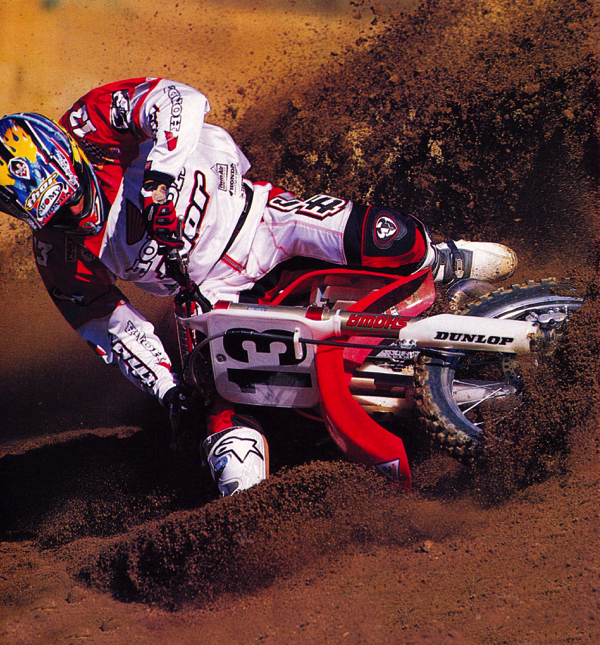 |
|
While Sebastien Tortelli showed several moments of brilliance in his years at Factory Honda, he never quite lived up to the expectations people had after his sterling run in Europe. In 2001, his best result in an otherwise disappointing season would be a victory at Hangtown in May. |
On the track, the Showa twin-chamber forks performed well in most conditions. The new stiffer springs and lighter damping curve alleviated some of the mid-stroke harshness riders complained about in 2000 (and every year since 1988), but on slap landings, the spike could still be felt. Some riders also complained of a “dead” feeling in the suspension that had been apparent since the switch to the aluminum frame. With the switch to the 20” wheel, the plushness improved, but it was still not in the same league as the excellent Yamaha’s KYB’s.
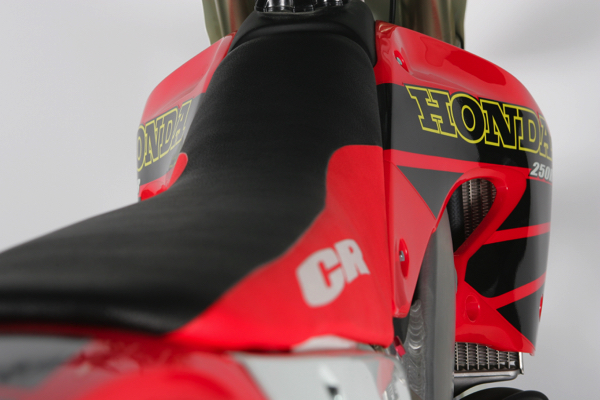 |
|
Excellent ergonomics and a comfortable seat were one of the CR’s virtues in 2001. |
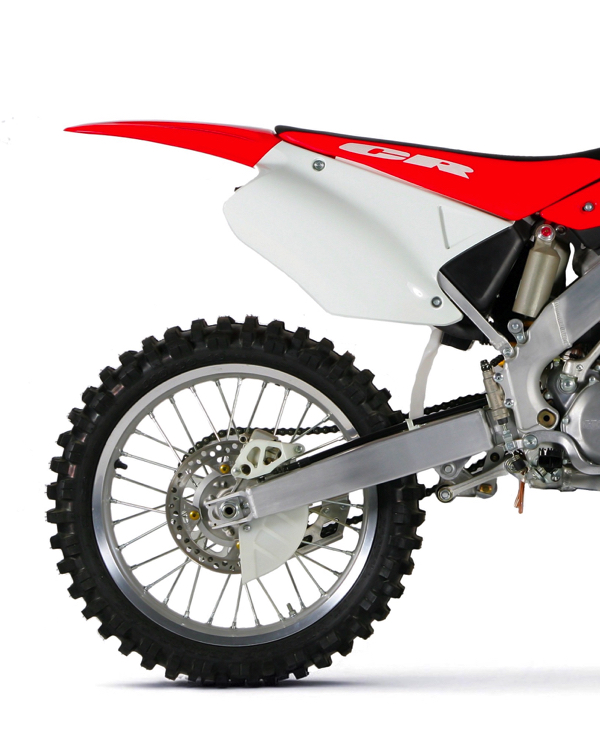 |
|
Buck it to me: Much like the front, the rear suspension on the CR left a little bit to be desired in 2001. It tended to kick in the stutters and offered a harsh overall feel. A step up in spring rate helped overall performance, but it was never going to be plush. |
Out back, the changes were only partially successful. The stiffer spring was a step in the right direction, but most riders felt it needed in increase in rate. It tended to drop down in the stroke on G-out and hard landings and imparted a harsh feel overall. Stutter bumps in particular seemed to flummox its valve stacks and the CR liked to kick in the rough under braking. With an increase in spring rate, the action improved, but once again it was never going to be as plush as the excellent Yamaha.
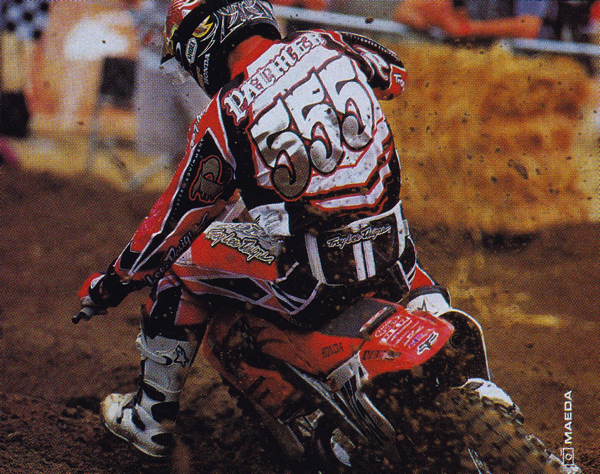 |
|
In 2001, action sports legend Shaun Palmer made an appearance at the first National of the year on a Factory CR250R. Unfortunately, Palmer would not get to show his speed in the motos, as a crash would end his day early with an injured hand. Photo credit: Donn Maeda |
Overall detailing continued to be excellent and the CR proved to be the best built of the 2001 offerings. Plastic quality, seat comfort and overall feel were excellent and the CR’s graphics were some of the most durable in the class. Both the clutch and brakes were trouble free and rated the best in the test. The new half-waffle grips were praised by most testers and proved comfortable enough to not demand an immediate aftermarket replacement.
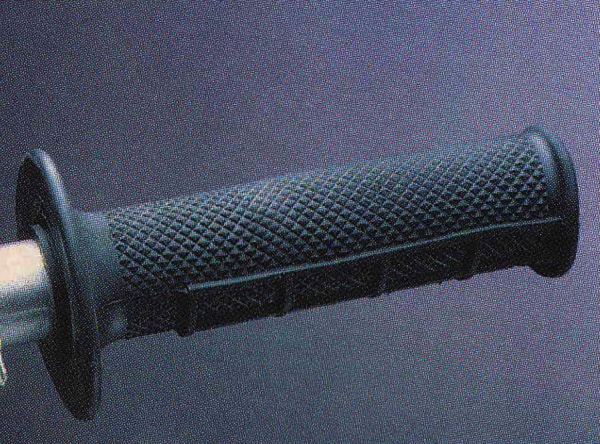 |
|
A new half-waffle grip was big news for 2001. This was the first grip redesign for Honda in twenty years. |
On the not awesome list were the CR’s annoying vibration (a problem since the switch to alloy to the frame in 1997), notchy shifting (uncharacteristic for Honda) and harsh overall feel. The addition of rubber mounted bar clamps helped slightly with the vibes, but the Honda continued to be the tingliest of the 250’s by a wide margin. The large alloy frame spars also made simple tasks like getting to the carb and adjusting the shock preload a major pain compared to the steel framed competition.
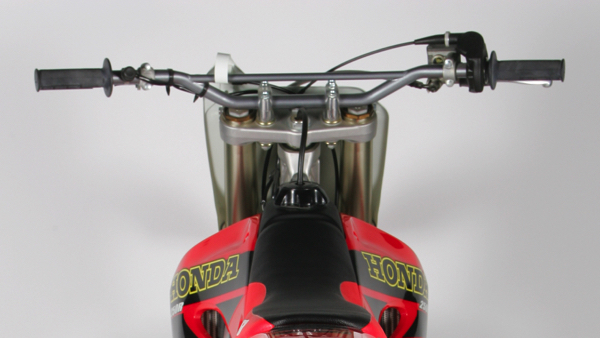 |
|
While overall quality was excellent on the CR, the inclusion of steel bars was starting to look very last century by 2001. |
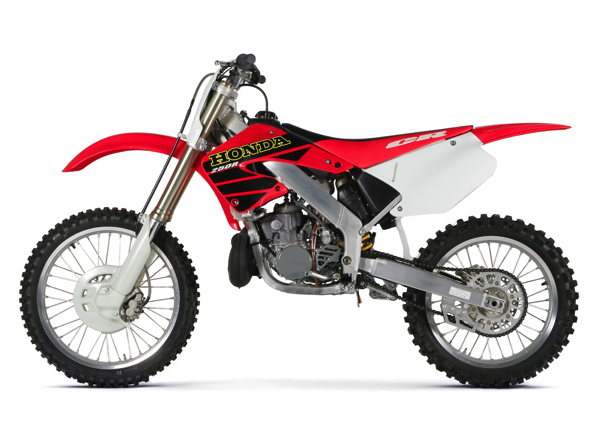 |
|
In 2001 Honda finally brought back the power that had made them so dominant a decade before. The new CR was fast and handled well, but it suspension continued to be weak spot in an otherwise solid package. In 2002, Honda would finally sort out the suspension issues that had plagued them since the late eighties, but the new case-reed motor would offer none of the verve that had made the CR a deuce-and-a-half legend. For many true two-stroke fans, the 2001 CR250R remains the last of the great Honda 250 smokers. |
In 2001, Honda took a solid overall package and finally brought back the one thing it was sorely missing, competitive power. The 2001 CR250R would see the last usage of the venerable 249cc power plant that had powered Hondas to countless victories and titles throughout the nineties. The all-new 2002 CR250R would see this mill retired in favor of a high tech new new case-reed motor that by most counts, was not nearly as good as the one it replaced. While this third (and last) generation two-stroke alloy chassis would prove the most refined of all the perimeter-framed CR’s, the glory days of Honda’s two-strokes were quickly fading into the rear view mirror. The arrival of the all-new CRF450R thumper for 2002 would herald a shift in focus away from oil-burners once and for all. Within few years, the whole of Team Honda would be on four-strokes and by 2008, the bike that started Honda’s motocross story would be little more than a memory. It was a sad end for a historic machine, but at least in 2001, it got to have one more day in the sun.
For your daily dose of old-school moto goodness, make sure to follow me on Twitter and Instagram -@TonyBlazier





